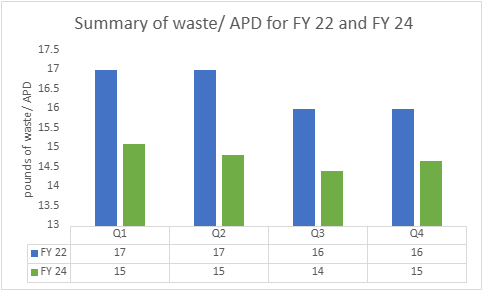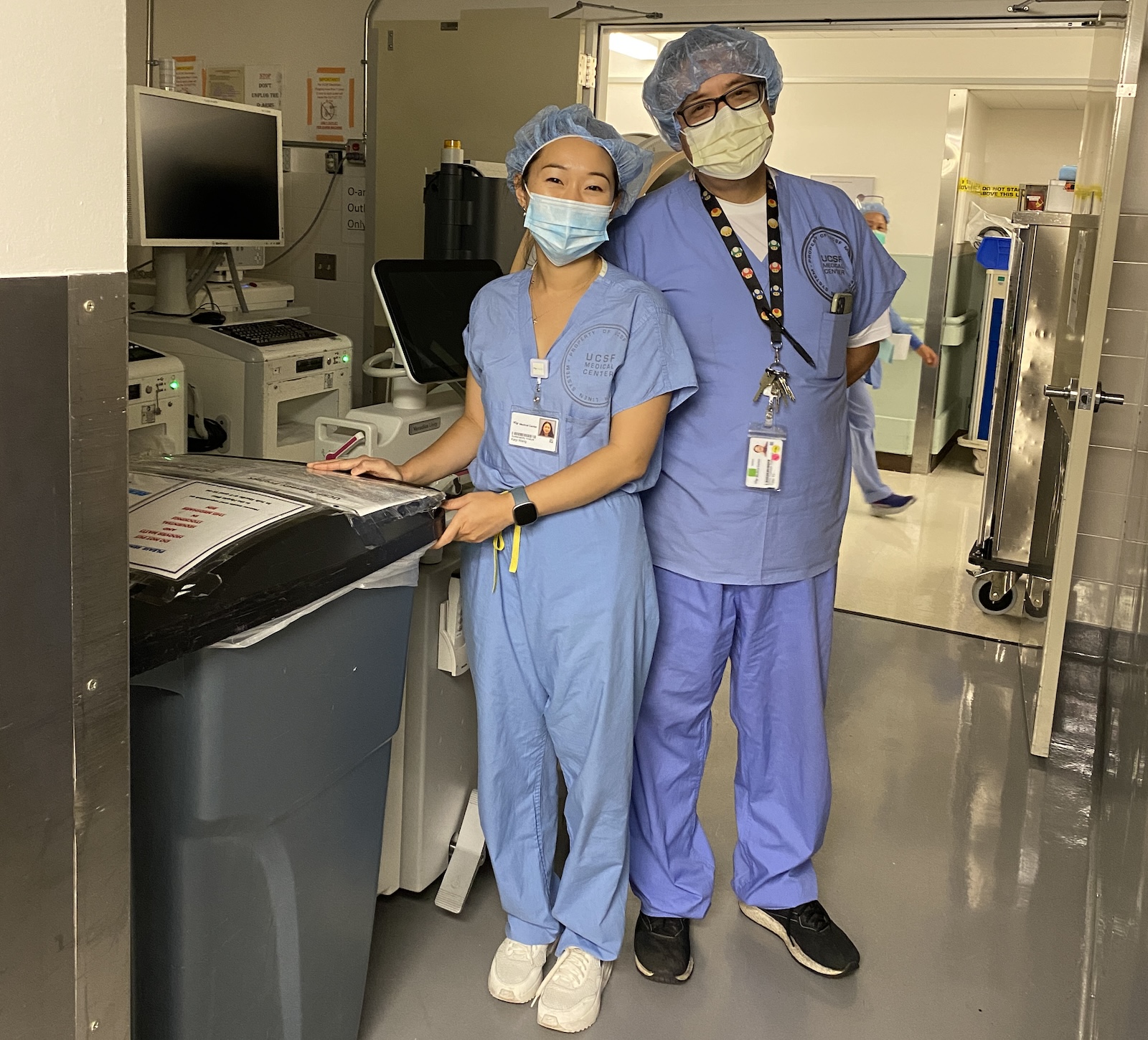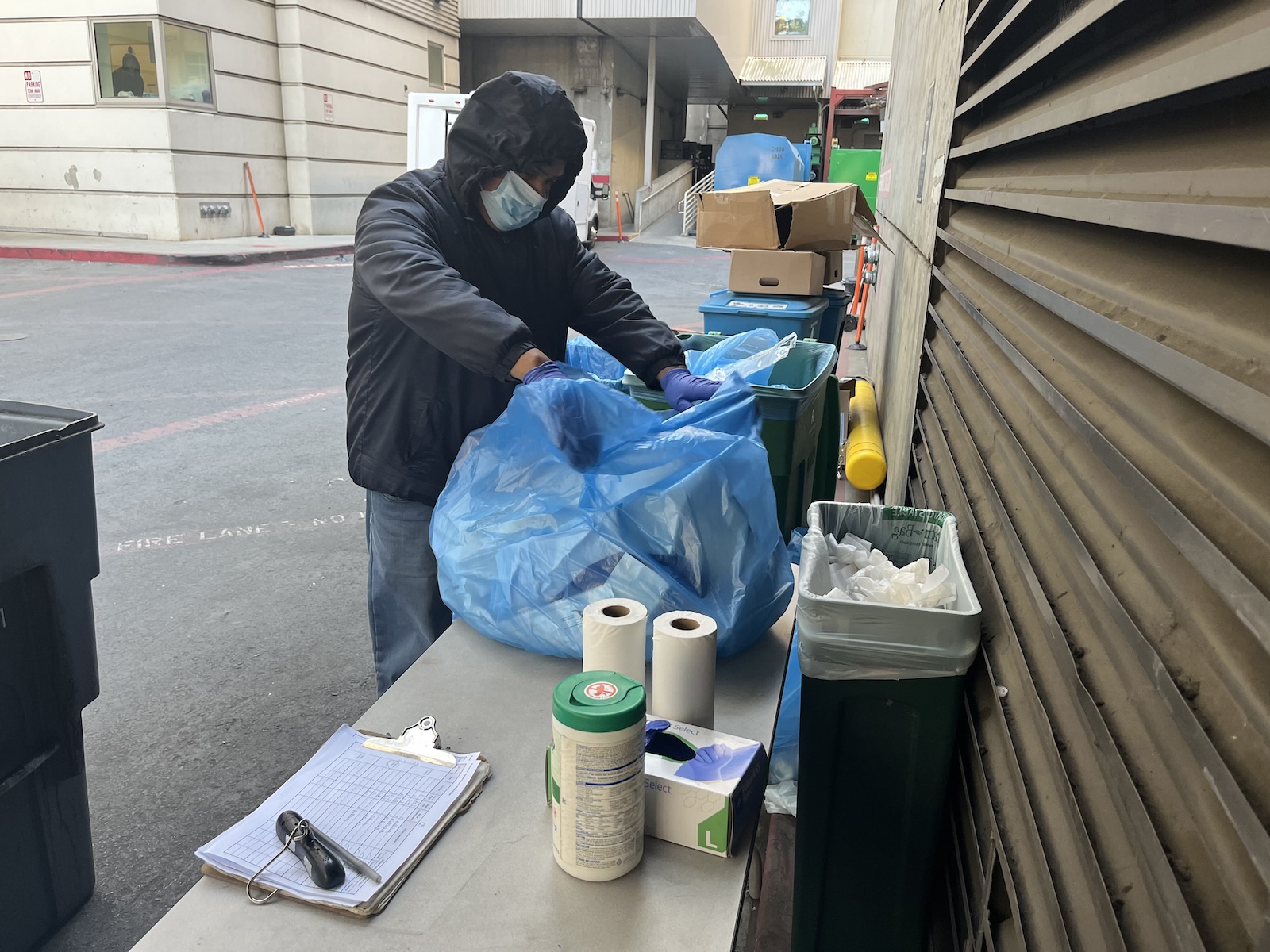Last fiscal year, the UC Health sustainability teams embarked on a Clinical Enterprise Management Recognition Plan (CEMRP ) goal focused on waste reduction. The five health systems already abide by the UCOP Sustainable Practices Policy, which requires achieving a target of 25 lbs of total waste per Adjusted Patient Day (APD) by 2025 and striving for 20 lbs of total waste per APD by 2030. The CEMRP waste reduction incentive tacked on another goal: reduce 300 tons of as a system in one year.
As a part of the UC Health system, UCSF Health is responsible for about 26% of the total combined waste. From the 300 tons of waste generated, this means our contribution toward waste reduction amounted to approximately 80 tons.
Our efforts focused on high-volume areas such as operating rooms (which are responsible for approximately 30% of a hospital’s waste), procedural areas, patient care units, and food service. We also focused our reduction efforts on the following waste streams: landfill, regulated medical waste, and hazardous waste. We did not focus on reducing waste sent to diversion streams so as not to get penalized for improving our recycling and composting programs.
The first three quarters of fiscal year 2024 showed great momentum, as we achieved a 40-ton reduction. However, the fourth quarter showed an increase in solid waste of approximately 24 tons. When compared to our baseline of FY22, UCSF generated 24 more tons of waste. This is likely due to a sharp increase in patient volume. However, when normalized by adjusted patient days (APD), every quarter in FY 24 showed a decrease in waste generated of 1.7, 2.0, 1.8, and 1.2 lbs/ APD.

Although we did not meet our goal of reducing 80 tons, we did implement various diversion projects and saw a decrease in waste when normalized again adjusted patient days. Waste reduction is tricky but UCSF Health remains dedicated to waste reduction initiatives and is continuously exploring opportunities to enhance our reprocessing program, explore new waste reduction strategies, and improve our current existing programs.
Here are a few key takeaways from our year-long goal:
1. Established a UCSF Health Zero Waste Working Group: This group was established to discuss waste reduction initiatives and work together to implement various programs. Key departments include sustainability, EVS, EH&S, Nutrition and Food Service, Material Services, and Perioperative.
 Two members of the UCSF Zero Waste working group. Kaiyi Wang (periop) & Tyler Yu (EVS Hospitality Services).
Two members of the UCSF Zero Waste working group. Kaiyi Wang (periop) & Tyler Yu (EVS Hospitality Services).
2. Blue Wrap: A blue wrap recycling program was implemented in the operating rooms at Mission Bay, Mount Zion, and Parnassus. Blue wrap, made from polypropylene (plastic #5), is used to maintain the sterility of surgical instruments and is a highly valuable plastic for vendors. Despite facing some challenges, we successfully partnered with a vendor to collect the material from the operating rooms. The collected blue wrap is then pelletized and repurposed.
3. Clean Recycling: Our improved recycling practices significantly contributed to reducing waste tonnage, with a key focus on expanding the volume of recyclable materials accepted. Collaborating closely with our local waste hauler Recology, the City of San Francisco, and Hospitality Services, we identified a key area for decreasing the contamination in our recycling and thus allowing it to be accepted by our hauler. We maintained our commitment to dumping our recyclable material loose (without plastic liners). As a result, we consistently maintained contamination levels below the acceptable threshold, ensuring the City's acceptance of our recyclables, totaling approximately 20 tons a month from our Parnassus Medical Center.
 EVS recycling sorter Narcisco Flores inspects recycling bags to ensure they are sorted correctly.
EVS recycling sorter Narcisco Flores inspects recycling bags to ensure they are sorted correctly.
4. Patient Positioning Foam: The sustainability department and medical faculty at the UCSF Medical Centers observed a significant amount of waste from disposable foam products being used to position patients during surgical operations. To reduce this waste, reusable gel positioning products were provided to the operating rooms.
5. E-waste: UCSF Health reignited our partnership with an e-waste vendor and resumed collections at all three medical centers. Our free monthly e-waste events offer staff an avenue to properly dispose of electronic waste.
6. Digital Sorting Signage: To encourage proper sorting, UCSF Health standardized waste stations with color-coded bins and signage. We also introduced digital sorting signage to raise awareness about where materials should be disposed. Displayed on idle monitors throughout the medical centers, the signage highlights common materials—such as cups, paper towels, food waste, PPE, and batteries—and their correct disposal streams. These reminders aim to reduce contamination and increase diversion at UCSF Health.
7. Sustainability Data Dashboards: We launched sustainability reporting dashboards to showcase UCSF Health's commitment to sustainability. The dynamic dashboards track progress on key metrics related to energy, water, green building, emissions, waste reduction, sustainable purchasing, transportation, and more. The zero-waste dashboard specifically highlights our waste reduction goals, initiatives, and progress, enhancing awareness and transparency.